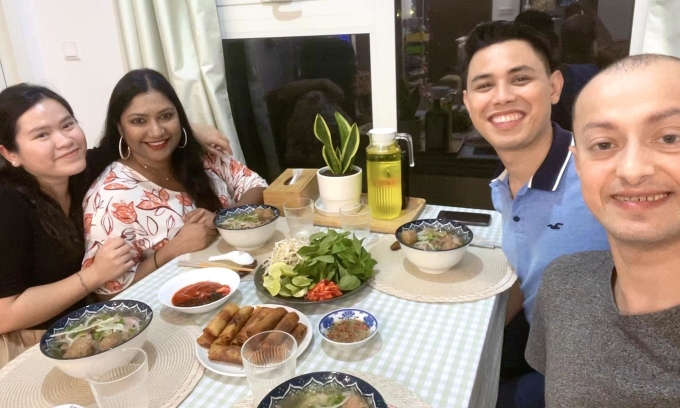A taste of Vietnam: Vietnamese woman sustains culinary heritage in Dubai
The 33-year-old relocated from HCMC to Dubai in 2016 for a hotel job. She initially stayed in the company’s dormitory, where the food was Middle Eastern, Indian, Filipino, or Chinese. Whenever she longed for the familiar flavors of home, she had to resort to the instant noodles she had brought from Vietnam.
By her second month she began to intensely miss Vietnamese foods like pho and good bo (beef noodle soup).
Once her instant noodles ran out, she began to explore food stores in Dubai and downloaded nearly a dozen delivery apps to buy the ingredients needed to cook her own meals.
“Vietnamese dishes helped me feel less homesick and satisfy my cravings,” she says.
Due to her hectic schedule, she could only manage to cook once a week. Often, after a late shift at work, she would trek 20 minutes through the desert to buy morning glory to take home to boil. She also prepared a dipping sauce by mashing garlic and chili. Despite its simplicity, Trang found the dish “incredibly delicious.”
Hoang Mai Trang (far L) enjoys Vietnamese dishes with her family and friends in Dubai. Photo courtesy of Trang |
About 70% of the Vietnamese dishes Trang makes require pork. But in Muslim Dubai, pork is rarely sold and only at a few licensed supermarkets, hidden away in secluded corners. On one occasion she had to travel 10 kilometers to buy pork.
One time some colleagues saw her cook pork and reacted loudly and violently. After this she was compelled to cook discreetly in her private room using a rice cooker for dishes like braised pork with eggs and good shit (vermicelli noodles and pork balls).
This continued for a few months until she connected with other Vietnamese in Dubai, who then gathered on weekends to cook together.
However, making Vietnamese food continues to pose challenges. Ingredients are costly. For example, a 100-gram bunch of morning glory costs VND42,000 (US$1.7). The same is true for perilla leaves, cilantro and green onion.
Additionally, most poultry sold in Dubai, including chicken and duck, is frozen and without offal. Trang often has to reach out to Vietnamese online to source giblets needed for making traditional Vietnamese noodle soups or porridge.
Sometimes, she has to procure ingredients from Vietnam since they are too expensive locally.
“Cooking a Vietnamese meal here usually costs a few million dong (VND1 million = $40.63),” she says.
To economize, she often cooks multiple dishes from an ingredient. For instance, she uses pig intestines for both vermicelli and porridge, and howling fish to make soup and braise with pork belly. She only adds a few sprigs at a time whenever she uses aromatic herbs like perilla, fish mint, cilantro, and Vietnamese coriander sparingly.
 |
A meal consisting of traditional Vietnamese dishes made by Trang in Dubai in March 2024. Photo courtesy of Trang |
Finding the right spices for Vietnamese cooking is another hurdle. She often has to visit up to four supermarkets just to find a bottle of Thai fish sauce that closely resembles the Vietnamese version.
“But I’m not always lucky,” she says. “It’s frustrating when I can’t find or don’t have some ingredients [to cook]and so I learn to make it myself.”
On one such occasion, she learned from online tutorials how to grind leftover rice, adding salt, tapioca starch and cooking oil to make noodles. This produced noodles that were soft and absorbed the broth well, closely resembling those made in Vietnam, she says.
Practice has improved Trang’s skills, such as when making banh bot loc (tapioca dumplings), she has learned to use silicone molds intended for jelly to achieve nearly the same taste and form as the traditional Vietnamese version.
Foreign friends frequently admire Trang’s dedication and attention to detail when she meticulously prepares vegetables like morning glory, hand-picks basil leaves for an hour or makes satay for hours though it is just five small jars to store away.
“My foreign friends perceive Vietnamese cuisine as detailed and meticulous, and missing one ingredient makes the dish incomplete,” she says.
In 2019 Trang married her Egyptian husband, who quickly became an enthusiast of Vietnamese cuisine. He is particularly impressed with Cuon cake (steamed rice rolls) for the skill required to make the layers very thin.
On weekends now Trang often invites foreign friends to savor more complex dishes like hotpot with fermented fish and porridge with pork intestine. Good bo is the dish most requested by her Indian and Arab friends.
It typically takes her two weeks to get all the necessary ingredients for these dishes.
During the Lunar New Year holidays Trang and her husband devote a week to visiting Chinese supermarkets, where they buy pickled radish to enhance with lime juice and sugar and serve as a side dish with braised pork and eggs.
She also purchases bamboo trays and banana leaves to present the dishes, recreating a Vietnamese atmosphere that her friends greatly appreciate.
“I see it as a way to introduce Vietnam to my foreign friends,” she says.


Comments are closed.